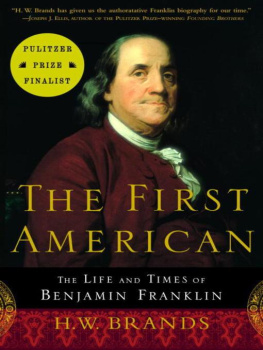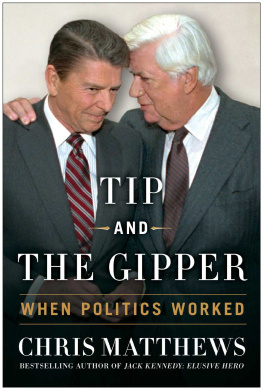TIP ONEILL
AND THE DEMOCRATIC CENTURY
John Aloysius Farrell
To Catharina
Copyright 2001, 2013 by John A. Farrell
Cover photo:
Side shot of Thomas P. ONeill, Box 455, Folder 6
Thomas P. ONeill, Jr. Congressional Papers (CA2009-01)
John J. Burns Library, Boston College
Cover design by Antonella Iannarino
All rights reserved. No part of this book may be used, reproduced, downloaded, scanned, stored, or distributed in any stored in any form or manner whatsoever without the express written permission of the author. Please do not participate in or encourage piracy of copyrighted materials in violation of the authors rights. Purchase only authorized editions.
For information, address John A. Farrell, c/o David Black Agency, 335 Adams Street, Brooklyn, NY 11201.
www.jafarrell.com
Originally published in hardcover by Little, Brown and Company, March 2001
First Back Bay paperback edition, August 2002
Praise for John A. Farrells
Tip ONeill and the Democratic Century

A New York Times Notable Book of the Year

Illuminating . Here is our political past, presented clearly and with style . This is not a typical biography, but a more panoramic production, a newsreel of nearly three-quarters of the last century. We see Tip ONeill compete with the startling events of his time, events he influenced, or observed from the inside . Farrells book is popular history, but of a superior sort. Through the person of ONeill he makes the nuts and bolts of governing, at both the state and national level, fascinating and understandable.
William ORourke, Chicago Sun-Times
Mr. Farrells impressive, fair-minded book is full of vivid stories about the old-style politics of Tip ONeill, bringing to life one of the most colorful political figures of the twentieth century.
Jonathan Karl, Wall Street Journal
A knowing and engaging biography of ONeill, a lucid chronicle of his times, and a wonderfully realized portrayal of the settings in which he spent his life: Boston during the first half of the twentieth century and Washington during the second half . Jimmy Breslin called Tip ONeill a lovely spring rain of a man and John A. Farrell proves Breslin right . Farrell has written a book as lovely as its subject, and also as big and accomplished.
Michael Nelson, American Prospect
I read this book through a six-hour delay at La Guardia followed by a transcontinental flight, and as my plane made its descent into San Francisco, I wished I were continuing to Hawaii.
Jack Beatty, Atlantic Monthly
John Farrell, the Boston Globes outstanding Washington correspondent, brings sympathy and affection and an acute political mind to this engrossing biography.
Martin Walker, New York Newsday
What Farrell has demonstrated is that five years of back-breaking reporting and the narrators art can add instruction to genuine entertainment . Read this book, and then you wont have to read anything else.
Tom Oliphant, Boston Globe
John Aloysius Farrells long, detailed, and fascinating book is more than the definitive biography of a flawed but startlingly successful old-fashioned political leader. Its also a guided tour through American governmental history from the beginning of the New Deal through the Reagan years . Farrells work is meticulously documented; his writing lucid, cogent, and frequently eloquent; and he has gone to considerable lengths to ensure completeness of the historical record in a warts-and-all presentation . An entertaining book and a valuable history.
Mario Cuomo, New York Times Book Review
An absorbing and evocative look at the life of the hulking Irish pol from Boston whose rise paralleled the ascendance of New Deal liberalism and who became its most stalwart defender in the Reagan years.
Bill Turque, Newsweek.com
A meticulously comprehensive biography . A grand picture of the most affable of public men.
Rob Mitchell, Boston Herald
Tip ONeill and the Democratic Century is both scholarly and breezy, admiring and objective.
M. Charles Bakst, Providence Sunday Journal
Farrell, an award-winning White House correspondent for the Boston Globe, manages not only to capture ONeills inner motivations but also to convey the intricate environment of the unwieldy modern House. Beautifully written, lively, and highly informative, this book excels not only as the best available biography of ONeill but also as the most readable book for those who want to understand the modern Congress. Political junkies will savor it, the public will learn from it, and academics will want to use it in their classrooms.
Library Journal
Contents
That justice is done, that mercy prevails.
January 1977
T HOMAS P. ONEILL JR., known by all but his closest friends and kin as Tip, was sixty-four on January 4, 1977, the day he took the oath as Speaker of the U.S. House of Representatives. Nudged by his wife, Millie, he had purchased a new suit for the ceremony: a formal charcoal gray ensemble with an eight-button vest, size 48 long, from Castignetti Bros. in Bostons North End, a onetime part of the congressional district he had represented for twenty-four years. He started the day with Mass at the Cathedral of St. Matthew the Apostle, where during his years in Washington he had honored the holy days of obligation of the Roman Catholic Church and from where, in November 1963, he had joined the throngs to say good-bye at the funeral of President John F. Kennedy. After church, arriving at the Capitol, ONeill had welcomed his mentor, former Speaker John McCormack of Massachusetts (Tom, Tom, Im awfully proud of you today. Awfully proud), and other well-wishers in the majority leaders suite. There, he treated reporters to the first of a decade of casual, informative press conferences, a departure from the practices of his grim and tight-lipped predecessors, none of whom would have warned a journalist that his coat was on fire.
To a learned eye, there was an anomaly in the majority leaders office, which ONeill had occupied for the preceding four years. Painted on the ceiling was the state seal of Louisiana. In the fall of 1972, a small plane carrying Representative Hale Boggs, a Louisianan who was then the majority leader, had disappeared in the wilds of Alaska. ONeill, at the time, was the Democratic whip, a rung below on the leadership ladder. The search for Boggs was historic in scope, but a failure nonetheless. His seat was declared vacant; ONeill ran and won the leaders job, and as a sign of fealty left the ceiling as it was. Boggs was a few months younger than his whip, and had the orange-and-white Cessna not vanished over icy Turnagain Arm, it is unlikely ONeill would ever have gone on to become Speaker.
Eleanor Kelley, ONeills secretary, had taken on the job of redecorating the new Speakers private office, on the East Front of the Capitol, in Massachusetts blue and gold. After unsuccessfully inquiring about the availability of JFKs Oval Office furniture, she had persuaded the Smithsonian to loan her boss a massive oak desk used by Grover Cleveland in the four-year hiatus between his two terms as President.
The gavel ONeill selected to rap the House to order was the very one he had wielded as Speaker of the Massachusetts House in 1949. It had splintered from hard use in that most testing of political arenas, but been repaired and preserved like a holy relic. He had been but thirty-seven, one of the youngest Speakers to preside in Bulfinchs golden-domed State House in Boston; the first Irish Catholic and first Democrat ever to hold the office in a state where politics was steeped in the enmity of the Irish and the Yankees and so uniquely defined by ethnicity, wit and malice. Casting back, I think that probably was the bigger day, he said, when the press asked him to compare the two swearing-in ceremonies, and the answer spoke volumes about what yet drove the man.
Next page








